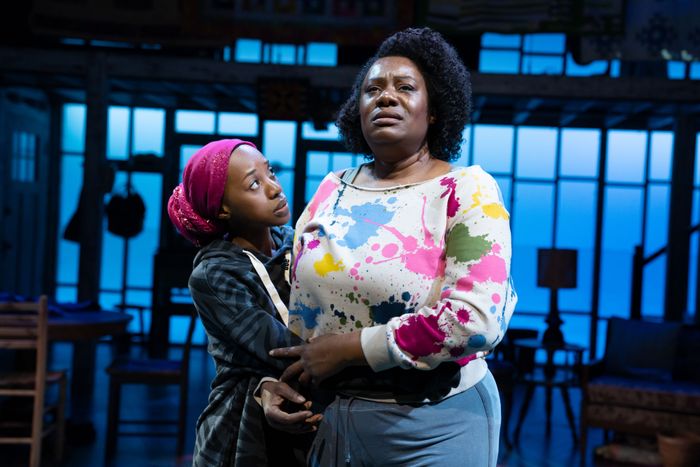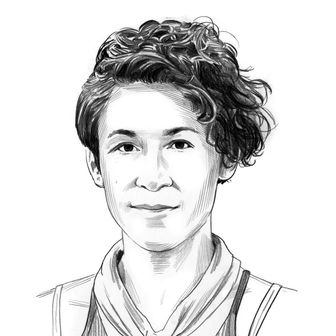
How much your heart thrills to The Blood Quilt will probably depend on your tolerance for a well-trod dramatic form: the big-boned, trauma-haunted family-inheritance play. It struck me while watching the tensions mount and the secrets spill among the Jernigan sisters at the heart of Katori Hall’s story—well, half-sisters; the four Jernigan women share a mother but all had different fathers—that the genre might actually qualify as a subspecies of that other tale as old as time: A stranger comes to town. After all, there’s always one prodigal — one unstable element who’s removed themself as far as possible from the precarious family mixture. But now, today, something will draw them back, and the reaction will be explosive.
The truth, of course, is that everyone is unstable, and it takes the return of the wanderer to bring decades of buried grievances and unhealed wounds to light. It’s happening on Broadway right now in The Hills of California, but whereas Jez Butterworth’s siblings are gathering around a mythic mother who’s still clinging to life, if by a very thin thread, the looming matriarch of The Blood Quilt has already died. It’s been three weeks, and the Jernigan sisters are reuniting in the house where they grew up, a seaswept cottage on a fictional island off the coast of Georgia, for the family’s annual quilting bee. The island’s name, Kwemera, says the eldest sister, Clementine (Crystal Dickinson), comes from “that old old Geechee tongue. Means ‘to last. To endure. To withstand.’ Like the Jernigan women. Like these quilts.” Hall doesn’t hesitate to lay her symbols right out. The sisters have all had the craft of painstakingly fine stitchwork drilled into them by their mother, but even so, subtlety isn’t the name of the game in their story.
It’s not that boldness is never the best choice; rather, the mounting frustration of The Blood Quilt arises from its increasingly blatant pile-up of contrivance. This kind of emotionally engorged, let’s-have-it-all-out play calls, first and foremost, for Good Acting—or at least for Much Acting—and it can trap talented actors in a box built of forced gestures and cringy tropes. Lileana Blain-Cruz has about as powerful a five-person cast as you could hope to assemble on a New York stage, but they can’t change Hall’s structure; they can only inhabit it.
And they do, fiercely and fully, despite the building’s fundamental shakiness. Dickinson and Adrienne C. Moore are especially settled into themselves as the two oldest siblings and the ones who’ve remained closest to home. Dickinson’s Clementine is her mother’s staunchest defender, the maintainer of traditions and the carrier of memories, a ferociously loyal caretaker with both a mystical streak and a hard, keen edge. Second in line, Moore’s Gio is the loud, don’t-give-a-shit aging brat whose pot-smoking and sometimes vicious fun-poking predictably mask the deepest hurt. More restrained than her older sisters, Cassan (Susan Kelechi Watson) is a nurse living on the mainland with her identity-seeking teenage daughter, Zambia (Mirirai). Cassan’s army husband might as well be a ghost, and not too far beneath her reserve lie her own sharp tongue and the bitter weight of, as Hall describes it, “being a married single parent.” Then—arriving, just as in The Hills of California, from that dreamy place of bigger, brighter lives and their sordid flip side—there’s the baby, Amber (Lauren E. Banks). Willowy and ambitious, with a $500 weave and a $795 jacket, Amber’s an entertainment lawyer in Hollywood. She is not a regular quilting-bee attendee. And she missed her mother’s funeral.
So Blain-Cruz’s stage—lushly designed by Adam Rigg with tendrils of Spanish moss and a wraparound coastal pool—is set for a showdown as surely as if there were tumbleweeds blowing across it. (If we needed more of a hint, Amber’s here to brief us: “Lil’ Vernon said there’s a storm coming,” she reports when she arrives, having been warned by one of the local ferrymen.) Part of what’s discouraging about The Blood Quilt’s long crescendo of trauma excavation is that you can feel the whole show reaching for something vaster and more otherworldly, something beyond the veil of simple human wrangling, but no one, neither playwright nor director, ever really braves the leap. Despite the sisters’ talk about haints and shadows, despite the stories they share of their ancestors—brought to Kwemera on slave ships and traditionally buried at sea ever since one of their mythic foremothers leapt to her death in the waves rather than come aground enslaved—a stale realism still pervades the production. Projections designer Jeanette Oi-Suk Yew and sound designer Palmer Hefferan sometimes create crashing waves against Rigg’s set, and every so often something happens in Jiyoun Chang’s lighting that piques the brain for a moment, but no consistent vocabulary of the beyond ever emerges. When the play reaches its climax, a moment of haunted stage trickery that’s supposed to thrill and engage us ends up feeling ungrounded and, in its aftermath, bizarrely underacknowledged. Neither Hall nor Blain-Cruz has built a world where magic is real.
Where Hall does thrive is dialogue. The Jernigan women’s banter flows with an easy, rollicking rhythm and wicked humor. No one here is gentle; everyone’s trained to spar. “I’m an activist,” insists Zambia, who’s shown up wearing a hijab — to which her mother claps back, “You are not an activist, you just acting out is what you doing.” Cassan has already been plenty spicy in her response to Gio’s raised eyebrows: “Honey, she wants to be a Muslim, nah. Last week she wanted to be Goth. The week before that a vampire … Next week she gone be gay.” “She gone have to go up to North if she wanna do all that,” smirks Gio. The patter is zingy, but for all their moxie, Hall’s characters don’t always feel independent — too often, she puppets them into a position that she needs them to be in. “I’m a lesbian,” Zambia confesses to her aunt Amber later on, but the moment’s vulnerability has been undermined by Cassan’s joke. Even more awkwardly, Amber responds with, “Oh, well. I’m in the closet, too … I’m a Republican.” Hall has set her play in 2015, which these days feels like playwright code for “don’t @ me about politics,” but what’s the point of trying to abdicate from your context? I find it hard to buy that a teenager who considers herself an activist—even in 2015, even if she’s experimenting with personas—would so blithely respond to Amber’s disclosure: Once she discovers that Amber is a “fiscal Republican,” Zambia approves. “Then you alright with me. Bitches need to start being ’bout they money.”
Of all The Blood Quilt’s characters, it’s Zambia who’s most often shunted around to wherever it’s convenient for the plot to take her. Mirirai is a compelling actor, with definite access to a teen’s physicality and moods, but Hall hasn’t really written a teenager. Sometimes, Zambia speaks in exaggerated (not to mention dated) text-speak: “SMDH! But smiley face. Heart-Heart, still LMBAO! HashtagOhwellz!” Other times, she’s implausibly erudite for a tenth-grader. “How old are you again?” asks Amber incredulously at one point — but, for real, how old is she? Still other times, as in her big-upping of Amber’s politics, Zambia busts out with a position that feels diametrically opposed to whatever character she has been developing. “Auntie Gio right,” she says mournfully to the room during one of several throwdowns, turning a blameful gaze on Amber, whose big, freshly-outed secret involves an illness she’s been hiding. “She coulda infected you, mama. You coulda infected all of us.” This isn’t a character talking — it’s a vessel saying what a playwright needs to be said so that the conflict can roll on.
As The Blood Quilt lumbers toward its finish, Hall keeps loading it up with revelations, each one more ostensibly shocking than the last. Except that, inside the formulaic container she’s built, none of them is really a shock at all. The inevitable storm blows in, but by that point, its blows and buffets are too artificial to rattle us. There is, however, an element to the production that transcends that feeling of schematic craftsmanship: the quilts themselves. Rigg’s set is draped with dozens of gorgeous full-size quilts — hanging from balcony railings, tossed across furniture, folded up in baskets, half-finished on the Jernigans’ ancestral quilting frame, many reminiscent of work by the historic quiltmakers of Gee’s Bend. There are, I discovered, 85 in total, 69 of them on loan from members of the Brooklyn Quilting Guild (the show’s props supervisor, Olive Barrett—who made the titular “blood quilt” along with artisan Kristina Fosmire, from a design by Rigg—is a guild member). “When y’all was telling me these stories,” says Zambia to her mother and aunts, “all the lives woven into this fabric, I just got the tingles.” That feeling is real, generated by real objects so clearly created with immense labor and care. If only it were a feeling more fully evoked by the play itself.
The Blood Quilt is at the Mitzi E. Newhouse Theater at Lincoln Center through December 29.


